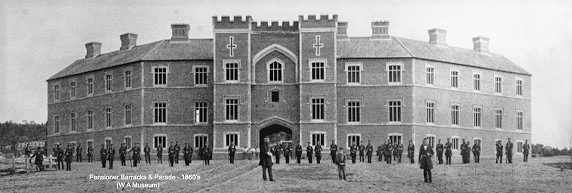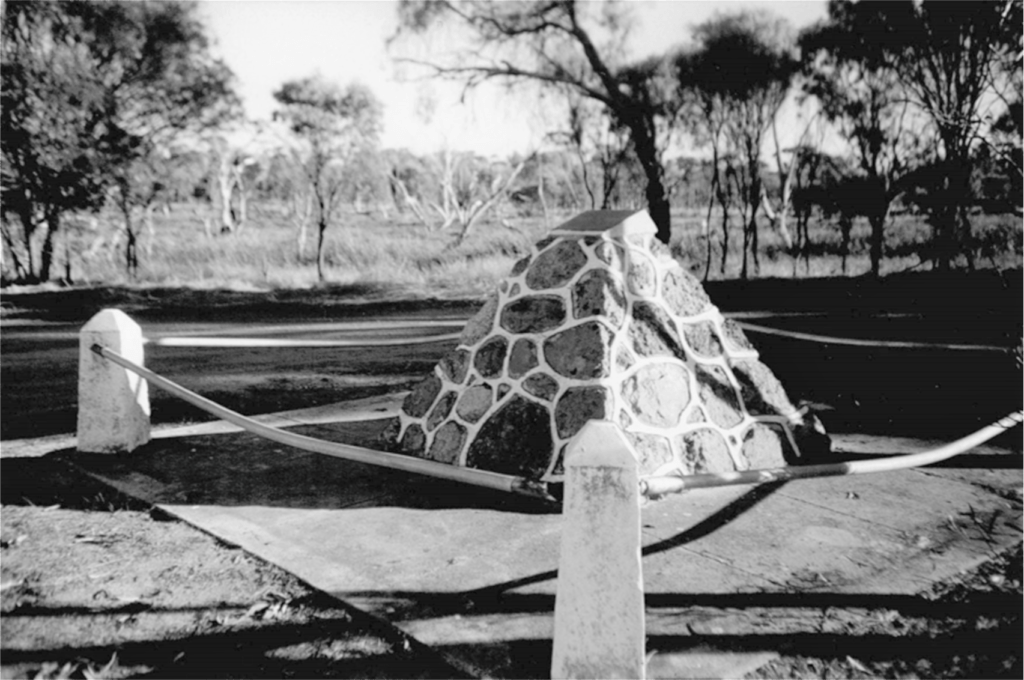Pensioner Guard
KATANNING’S FIRST POLICEMEN
THE PENSIONER GUARD
The Pensioner Guards [2] (also known as the Enrolled Pensioner Force and after 1880 as the Enrolled Guards) consisted of those soldiers who came as guards on the convict ships which transported nearly 10,000 prisoners to Western Australia in the years 1850-1868.

PENSIONER GUARD BARRACKS
Top of St Georges Terrace, Perth
To guard the convicts on roadwork, military depots were established at Kojonup, Arthur, Williams, Bannister and elsewhere. The soldiers were recruited from time-expired men of the British army, mostly from India. These pensioners were made grants of land to induce them to stay in the colony, and thus became pioneer settlers.
In the mid 1860’s many woodcutters and sheep owners were working and settling in the district of what is now Katanning. This early settlement caused some friction with the local aboriginal groups who had always travelled through the area.
A police presence was requested by the white settlers and, in 1865, the first trooper was stationed at what became known as Eticup Station, located near a freshwater reserve. Twonkwillingup (the place of frogs) was an important meeting place and water source for local Aboriginals (Noongars) long before European settlement.
POLICE POOLS

POLICE POOLS MEMORIAL
Erected by the Katanning Historical Society to celebrate Katanning’s Jubilee
Twonkwillingup became known as Police Pools after the area was used as an outpost of the Kojonup Police Station from 1865 – 1870.
This was the original camp site of Katanning’s first police outpost in c1865. The First police officers (Pensioner Guards) were Sergeant Terrance McKenna: 1865 – 67, Trooper William Grover: 1867 – 70, and Trooper E.M. Fahey: 1870, serving for 2, 3, and 1 year respectively. It enabled them to visit isolated sandalwood cutters and early settlers in the area.
Police Pools memorial commemorates the first police camp in the Katanning district. Although nothing remains of the original cottage and stables, the site has high historical and social significance. The introduction of law enforcement in the newly settled area reflects race relations of the time. The aboriginals were seen as a threat by white people and had to be controlled by white laws in order for white settlements to succeed. The connection of police Pools to important early local identities also gives the site social significance.
A random rubble conglomerate stone cairn set on a concrete surround with four corner tapered concrete stanchions and tubular steel rails. The cairn has a bronze plaque. It is set in lightly wooded country alongside wetlands. In 2000 extensive beautification works were undertaken at Police Pools including the addition of walkways (broadwalks). This was completed as part of the “Work for the Dole” Scheme.
1958 (memorial), 1865 (Eticup Station). In the mid 1860’s many woodcutters and sheep owners were working and settling in the district of Katanning. This early settlement caused some friction with the local aboriginal groups who had always travelled through the area. A police presence was requested by the white settlers and in 1865 the first trooper was stationed at what became know as Eticup Station, located near a fresh water reserve.
The first policeman was Terrance McKenna, and he proceeded to erect a slab, daub and thatch two-roomed cottage and stable for himself and his family. After only two years the McKenna family left Eticup Station, and Terrence left the force and settled on their own farming land. McKenna was replaced by William Grover, who also left the force, in 1869 to start farming. His property was known as Springfield (later divided up into the two properties of Indinup and Wilgermar). Trooper E.M Fahey was the third and final policeman at the Eticup Station, which closed in 1873, Fahey having been permanently transferred to Kojonup.
SERGEANT TERRANCE McKENNA
Sergeant McKenna originated from Ireland with his wife Mary and their five children. He was the first officer appointed to the Katanning area and he proceeded to erect a slab, daub and thatch two-roomed cottage and stable for himself and his family. He left after two years and purchased farming land at Arthur River. His daughter Alice married Thomas Haddleton of Coompatine in Katanning.
TROOPER WILLIAM GROVER
Born at the Swan River settlement in 1837, William Grover arrived in Katanning in 1860 as a trooper at an outpost to the military station at Kojonup. He was the second trooper to be stationed here after Sergeant McKenna. In 1862 he married Bridget Noonan, from the original Noonan family in Katanning, and the couple had eleven children.
Shortly after his marriage, Grover resigned from his official position, to take up land with his brother-in-law, Michael Noonan, the two acquiring some 40,000 acres under pastoral lease in 1865/66. The property was originally known as Springfield, although the name of the property was soon changed to ‘Indinup’.

William and Bridget Grover (50th Wedding Anniversary)
TROOPER E.M. FAHEY
Trooper Fahey was the last of the Pensioner Guards to be posted to Police Pools. When the station closed in 1873, he was permanently transferred to Kojonup.
With the closure of the Police Post in that year, and the settlement of Katanning in 1889, Police Pools became a highly popular recreational facility. Daisy Bates also used this site when working in the area c1908.
Pensioner Guard
